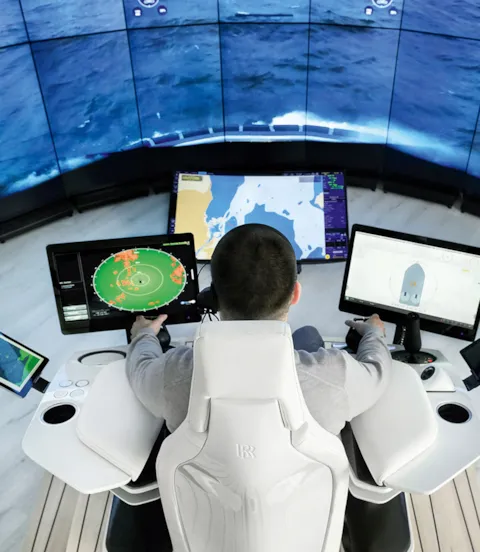Ship without a helmsman
Equipped with a new test bed, and with several research projects underway, autonomous shipping is one step closer to becoming a reality. DNV GL is developing the necessary rules.
The little craft bearing the DNV GL logo gingerly braves the waves as it skippers across the Trondheim Fjord under the watchful eyes of Kjetil Muggerud and Henrik Alfheim from the Norwegian University of Science and Technology (NTNU) in Trondheim. Both students are investigating how advanced control systems and navigation software could control an unmanned vessel, using a 1:20 model of DNV GL’s concept vessel ReVolt: “Advances in sensor technology, data analytics and bandwidth to shore are fundamentally changing the way shipping works. And as operations are digitalized, they become more automated,” says Dr Pierre C. Sames, Director of Group Technology & Research at DNV GL.
In 2016 government agencies and industry bodies established the Norwegian Forum for Autonomous Ships (NFAS) to promote the concept of unmanned shipping. In support of these efforts, the Norwegian government has turned the Trondheim Fjord into a test bed for autonomous ship trials. Other nations, most notably Finland and Singapore, are pursuing similar goals.
DNV GL is in the midst of this development, following its mission to make sure the technologies enabling autonomous ships will perform to the benefit of humans, their assets and the environment.
“Autonomy will be a game changer for the class societies,” says Bjørn Johan Vartdal, Head of DNV GL Maritime Research. “Traditionally we have been involved in approving ship technology, but the operational part we’ve left to the crew. But in autonomous vessels, the operation is embedded in the technology, it’s the software that decides how it will manoeuvre, so we will have to approve the safety of the whole operation. This is, of course, really challenging and it will have to be a case of continuous development,” he adds.

The human factor
DNV GL experts identified three main factors that could positively influence the uptake of autonomous shipping: automation reduces the potential for human error. With a battery propulsion system, as seen on DNV GL’s ReVolt model, an autonomous ship would also be lower in maintenance than conventional ships. Additionally, an unmanned cargo vessel would also become more economical, as eliminating the superstructure would save weight and create more cargo space. Furthermore, unmanned ships may be used in hazardous operations, for example firefighting, or as stand-by rescue vessels for offshore structures.

Small craft with great ambitions
DNV GL has initiated or is taking part in various projects revolving around ship automation and autonomous control. In the offshore sector, the unmanned offshore vessel Hrönn is currently under construction at Fjellstrand shipyard. The vessel ordered by a Norwegian and UK consortium led by Automated Ships and Kongsberg will be delivered in 2018. The light-duty, fully automated utility ship will be deployed in a shuttle service for offshore installations as a remotely piloted ship: to this end, the control systems, including dynamic positioning, automation and ECDIS, will be replicated at an onshore centre. Hrönn‘s sea trials will take place in Norway‘s officially designated automated vessel test bed in the Trondheim Fjord and will be conducted under the auspices of DNV GL and the Norwegian Maritime Authority (NMA). The Hrönn will ultimately be classed and flagged, respectively.

The challenges
Overall, autonomous shipping opens up great opportunities for the European shipbuilding and shipping industries. But new competencies have to be built before autonomous ships can become a commercially viable reality. Key research must be done to improve sensor technology, the acquisition of high-resolution ranging data and instrumentation accuracy. Software plays a very important role in this scenario by enabling situational awareness, a prerequisite for automated decision management.
While existing know-how from the aerospace and automobile industries can be leveraged, specific expertise in ship autonomy has yet to be built up. The research activities at NTNU, sponsored by DNV GL and industry stakeholders, are instrumental in creating a new generation of highly skilled ship autonomy experts.
Another concern is the operational availability of on-board machinery. No immediate repairs are possible on an unmanned craft so reliability of all mechanical and electronic components is of utmost importance. “In addition, having battery-powered unmanned vessels would eliminate movable parts from the power generation system and make them easier to maintain,” says Sames.
Segments that could see the first autonomous vessels in operation include ferries and offshore supply vessels operating in coastal areas or smaller cargo vessels operating in short-sea shipping.
However, the expert cautions that, as yet, there is no legal framework that governs the use of unmanned ships. DNV GL is developing a set of rules, but to avoid potential conflicts with international law autonomous ships will not be able to operate in international waters until the IMO develops appropriate regulations, which will take time. For the deep-sea segments, autonomous shipping is not an option today, says Sames. “These vessels travel distances that go beyond the range of battery propulsion, and they require well-trained crews on board who can respond quickly to any technical issue,” says Sames.
Additional crew support
However, advances in automation can benefit all industry segments in some way, even without fully autonomous control. In the future, some ship traffic could be controlled remotely from land-based virtual bridges – with one ship master overseeing several vessels at the same time. “But the most likely scenario is that the technology which enables autonomous ship operations will simply be an additional option for operation – meaning it could be used for specific purposes without fully replacing traditional, manned operations,” Sames suggests. “So, for example, autonomous navigation and control systems could support the crew in steering a vessel, increasing safety and optimizing operational efficiency.”

Pierre C Sames
Strategic Development Director, Maritime